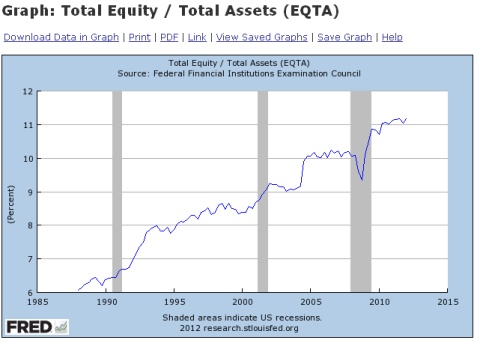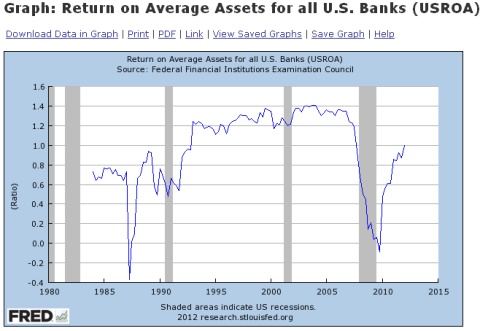Nudge, nudge, shove, shove. If you’ve not already found FRED, it is a veritable Eden of make your own graph fun from the Federal Reserve Bank of St. Louis.
Since the horrific moments when the banking system in the United States almost melted down under the weight of its own toxic assets, the result of their avaricious appetite for mortgages to transform into CDOs, and the consequent collapse of the Wall Street Casino in 2008, some sectors of the economy are doing better than others. The banking sector’s lines seem to be headed in the right direction.
Consider the following graphs:




Their returns are going up, their nonperforming loans and net loan losses are going down. Their profits are over the moon. So, why are the bankers worried about another four years of the Obama Administration? A quick answer: The Dodd-Frank Act.
One of the goals of the financial regulation reforms included in the Dodd-Frank Act was to create more transparency in the trading of credit default swaps. There was a reason investor extraordinaire Warren Buffett called such trades “financial weapons of mass destruction.” Opponents of regulation argue that if the swaps must be made through an exchange the transparency might make them less attractive to investors, and less suited to their purposes. What purpose is served if the trades are secret? If an investment has to be secret in order to be attractive, then we’d have to ask why the purpose can’t be exposed to the light of day? This isn’t to argue that the Dodd-Frank Act was perfect, far from it, but at least it lets a bit of sunlight into the shadows of the investment banking system.
Another goal of the Dodd-Frank Act was to mitigate the possibilities that bank holding companies who have the protection of the FDIC would abuse depositor’s funds by using them for or to backstop the activities of their trading desks. Those who didn’t like the Bank Bailouts begun under the Bush Administration, really shouldn’t like the attempts by the banking lobby to water down or delay the implementation of the Volcker Rule.
The GOP talking point du jour about “unnecessarily burdensome regulations” goes back to early 2011:
“House Republicans on Monday said they are drafting five bills to repeal or change parts of the Dodd-Frank financial-overhaul law that have been opposed by business groups.
The bills are to be discussed at House subcommittee hearing on Wednesday. The hearing “will provide an opportunity to discuss several proposals that address some of the act’s damaging provisions,” Rep. Scott Garrett (R., N.J.) said in a statement.” [WSJournal]
Let’s take a look at some specific Republican/Banking Lobby points of attack, i.e what do they allege are “damaging?”
Republicans aim to eliminate a piece of the law attempting to make credit-ratings firms such as Standard & Poor’s, Moody’s Investors Service and Fitch Ratings liable if their initial ratings turn out to be faulty.
House Republicans will also seek to exempt companies that use derivatives to hedge commercial risk from new requirements that they route their transactions through clearinghouses. Those companies have been lobbying for the change, arguing that the Dodd-Frank law leaves uncertainty about whether they would have to clear their derivatives trades.
They would seek to exempt private-equity fund managers from a Dodd-Frank requirement that they register with the SEC. While many larger private-equity funds are already registered with the SEC, small and midsize fund advisers have been arguing that the registration requirement is expensive and burdensome.
Republicans also aim to cancel another provision requiring publicly traded companies to disclose the median annual total compensation of all employees and calculate a ratio of how employee compensation compares with that of the chief executive.
Finally, Republicans will introduce legislation to boost the offering threshold for companies that don’t need to register with the SEC to $50 million from $5 million. Republicans say this change will make it easier for smaller companies to raise money for investment. [WSJournal]
(1) As noted herein many times, the ratings agencies weren’t just “faulty” in the run up to the Great Bubble Bust of 2008. Ratings agencies were paid by the issuers of the bonds (CDOs) and the better the rating the more likely they were to get paid. Not only was the conflict of interest obvious, in some cases it was blatant.
(2) If uncertainty is a problem, then why not allow the CFTC and other regulators to make the rules and get on with it. The Banking Lobby has all but moved Heaven and Earth to impede regulatory action. It doesn’t do to argue that the lack of regulation clarity is a reason for deregulation when you’re doing all you can to prevent the drafting of regulations much less the implementation thereof.
(3) Why would anyone want to operate away from SEC scrutiny, if the idea is that the hedge fund is advertising itself as a good place to invest? Yes, it may cost some money for some of the smaller funds to fill out the paperwork for SEC registration. However, which fund is obviously a better place to park one’s money — the fund that’s registered with the SEC and accepts oversight of its operations, or the fund that isn’t registered and isn’t overseen by anyone? Are smaller hedge funds really arguing that they can’t raise money for investments because they’d have to register if they had $5 million under management? It should appear obvious that one of the selling points of their management would be “We Are Not The Fly By Night” types — we are registered with the SEC — you can trust us.
(4) And why would any shareholder or investor not want to know if the executive compensation packages bestowed upon management are completely out of whack? If the major money is moving to the top, and the employees aren’t getting a fair shake, then what’s happening to the shareholders and other investors?
Senator Dean Heller (R-NV) is on record favoring the repeal of the Dodd-Frank Act because of the aforementioned “burdensome regulations.” However, someone somewhere along the line during the 2012 campaign season ought to be asking:
(a) Do you favor a return to the system in which ratings agencies could stamp CDOs with a AAA rating without any repercussions if it were demonstrated later that the ratings were the result of a conflict of interest?
(b) Do you favor a system in which some hedge funds are allowed to operate without supervision by the SEC? Even if they have as much as $50 billion under management?
(c) Do you favor a system in which executive compensation ratios are hidden from employees, shareholders and investors?
(d) Do you agree with the Banking Lobby’s strategy of impeding the drafting and implementation of regulations while contending that any delay creates uncertainty?
![]()




